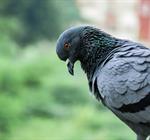
16 Aug 2023 | Apex Environmental Services (UK) Ltd
Bird Control in Urban Areas: Challenges and Solutions
Urban areas are bustling with life, not just of the human kind but of various other species. Amid the skyline, traffic, and crowds, a significant number of birds have made cities their home, and while these birds add charm to our urban environment and are often cherished for their melodies and beauty, there is no denying the challenges they bring. Effective management and control methods are crucial to ensure harmony between birds and humans, while also ensuring that birds are treated ethically and with respect.
Why birds pose a problem in big cities
Hygiene Concerns
One of the primary reasons birds can be problematic in urban areas is due to hygiene concerns. Bird droppings are not only unsightly on buildings, monuments, and cars, but they can also pose health risks. Accumulated droppings can become a breeding ground for a variety of pathogens. Pigeon droppings, in particular, contain fungi such as Cryptococcus neoformans and Histoplasma capsulatum, which can cause diseases in humans upon inhalation. These droppings can also result in slip hazards, especially on pavements and public spaces when wet.
Damage to Buildings and Infrastructure
Birds, especially those that nest in large numbers, can cause damage to the exteriors of buildings, signage, and other infrastructure, and can also clog drainage systems with their nesting materials, leading to potential flooding or water damage. Furthermore, acidic bird droppings can erode building materials over time, leading to costly repairs and decreasing the aesthetic appeal of structures.
Noise and Disruption
Certain bird species can be particularly noisy, especially during breeding season. In urban settings, where the hustle and bustle are a constant, adding the cacophony of hundreds of birds can be disruptive for residents and businesses. This is particularly the case for species that are active at dawn or dusk, as their calls can disturb people's sleep or quiet moments.
Collision and Safety Risks
Birds can pose safety risks, especially near airports where bird strikes can be hazardous to flights. Even in urban areas, there is an increasing number of reports of drones colliding with birds. Additionally, larger birds, if startled, could potentially lead to accidents if they fly into road traffic or crowded areas.
Competition with Native Species
Many urban areas have seen an influx of invasive or non-native bird species that can outcompete or push out local species, and the displacement of native birds can upset the ecological balance, leading to unforeseen consequences for local flora and fauna. An example is the rise of the ring-necked parakeet in parts of the UK, which competes for nesting sites with native species.
In understanding these challenges, it's clear that while birds are a delightful aspect of urban life, they can also bring with them an array of complications. Addressing these issues requires effective and ethical bird control solutions which we will explore in the following sections.
Effective bird control solutions
Anti-bird Netting
An anti bird netting system is among the most effective solutions to keep birds away from specific areas without causing them harm. Made from durable materials, these nets act as a barrier, preventing birds from entering or nesting in protected zones. Often used for protecting structures, monuments, and open spaces, netting is discreet and allows for both light and air to pass through. This method is particularly effective for larger areas like rooftops, balconies, and courtyards, ensuring they remain free from droppings and nesting materials.
Cruelty-free Spikes
Bird spikes, when designed to be cruelty-free, act as a deterrent rather than a trap. These spikes prevent birds from landing or nesting on ledges, sills, and other flat surfaces, and while they may appear sharp and dangerous, cruelty-free versions ensure that birds aren't harmed. Instead, they merely find the area uncomfortable to perch upon, leading them to seek alternative resting places. These are particularly useful in protecting signage, ledges, and architectural features from bird-related damages.
Post and Wire System
Another discreet and humane method, the post and wire system involves setting up a series of thin wires supported by posts across flat surfaces. When birds attempt to land on these wires, they find it unstable and uninviting; this method is effective in preventing birds from settling without causing them any harm. It's a popular choice for historical buildings and monuments where the aesthetics of the structure need to be preserved while also ensuring protection from bird-related problems.
Audible and Visual Deterrents
Incorporating devices that produce predator sounds or using visual aids like reflective tapes or predator replicas can act as effective deterrents. Birds, being prey animals, are instinctively wary of these cues. However, it's essential to rotate or change these deterrents regularly to prevent birds from getting accustomed to them. While this method can be effective in certain situations, it may not be ideal for densely populated areas where the noise or visual aspects could disturb residents.
The Bottom Line
Ultimately, birds are an integral part of our urban ecosystem, bringing life, colour, and music to our cities. While the challenges they present in urban settings are real and sometimes costly, it's essential to approach the issue with empathy and a focus on humane treatment. The methods listed above not only ensure the safety and cleanliness of urban areas, but also make certain that birds are treated with the respect they deserve.


